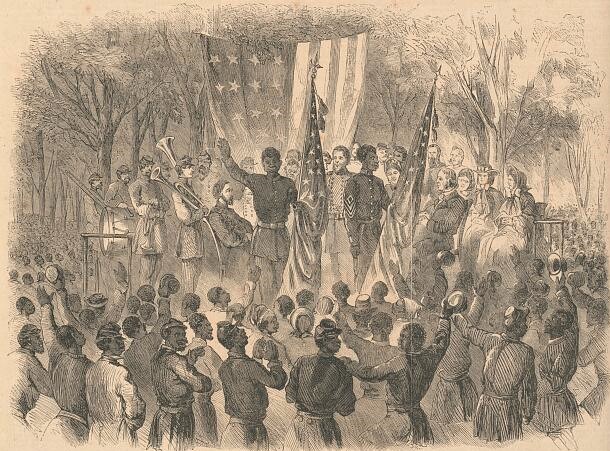
First South Carolina Volunteers’ color guard addressing a crowd after reading the Emancipation Proclamation on Jan. 1, 1863. Library of Congress
How to register:
We offer two field trip scheduling options:
- Select a field trip from the Museum’s public event schedule
- Request to schedule a field trip at a time that meets your group’s schedule
Audience:
All audiences. Content appropriate for Grades 6-12.
Goal: Recognize the commitment, sacrifices, and challenges of Black Soldiers who ensured that the Constitution fulfilled its promise to all Americans.
Program Description:
In June 1865, Maj. Gen. Gordon Granger arrived in Galveston, Texas with roughly 2,000 Union Soldiers. Though his main goal was to bring an end to the Civil War and welcome Texas back into the Union, he had another objective. On June 19, Granger issued General Orders No. 3 declaring that “the people of Texas are informed in accordance with a Proclamation from the Executive of the United States all slaves are free.” While the Emancipation Proclamation issued by President Abraham Lincoln legally freed slaves throughout the Confederate States, Texas resisted for two years. Granger’s order had the effect of liberating 250,000 people who had been in enslaved in Texas.
Juneteenth, alternatively known as Jubilee Day and Emancipation Day, became one of multiple local holidays commemorating the official end of slavery at different points throughout the South. For the Army, it also honors Black Soldiers who fought and sacrificed to ensure the Constitution fulfilled its promise to all Americans.
Discover the role of the U.S. Army in the liberation of enslaved persons throughout the Confederacy. Explore the courageous, selfless, and dedicated service by Black Soldiers that cemented the gains provided by the Civil War and opened the door to widespread military service for Black men in the U.S. Army.
Objective: At the end of this lesson students, will be able to
- Recognize the U.S. Army’s role in the liberation of enslaved persons throughout the Confederacy.
- Identify the scope and impact of the Emancipation as it is related to the U.S. Army.
- Understand how the U.S. Army supported Reconstruction after the Civil War.
- Discuss how the courage, selfless service, and dedication of Black Soldiers opened the door to widespread military service for Black men.
Guiding Questions:
What was the U.S. Army’s role in the liberation of enslaved persons throughout the Confederacy?
Curriculum Connections
Common Core Standards
- CCSS.ELA-LITERACY.RH.6-8.2
Determine the central ideas or information of a primary or secondary source; provide an accurate summary of the source distinct from prior knowledge or opinions.
History and Social Science Standards of Learning for Virginia Public Schools
- United States History to 1865
- USI.9 The student will apply history and social science skills to understand the cause, major events, and effects of the Civil War by:
- e) describing major political texts during the war, including but not limited to Lincoln’s Inaugural Address, the Emancipation Proclamation, the Gettysburg Address, and Lincoln’s Second Inaugural Address;
- f) Analyzing the effects of the war from various perspective of Union and Confederate soldiers, indigenous peoples, women, European Americans, and enslaved and free Blacks during the war including, but not limited to Clara Barton, John Brown, Robert Smalls, Harriet Tubman, Elizabeth Van Lew, and Mary Bowser.
- USI.9 The student will apply history and social science skills to understand the cause, major events, and effects of the Civil War by:
- Virginia and United States History
- VUS.9 The student will apply social science skills to analyze the major turning points of the Civil War and Reconstruction eras by
Your message has been submitted.
